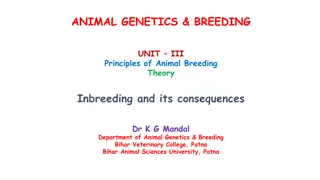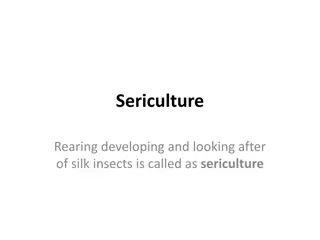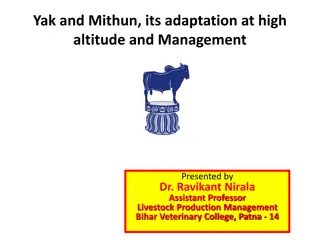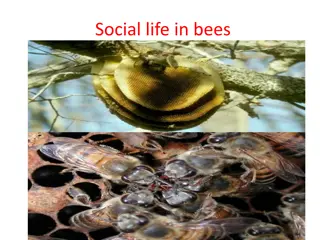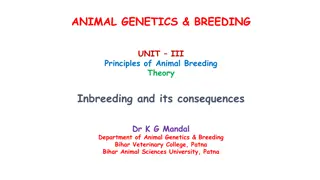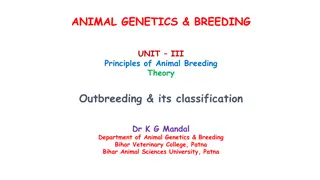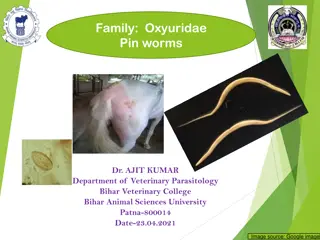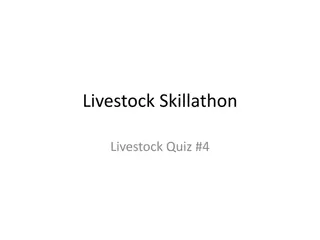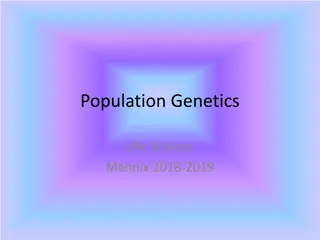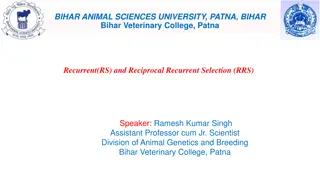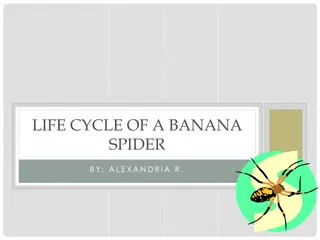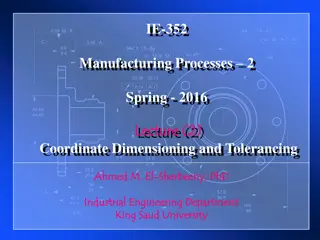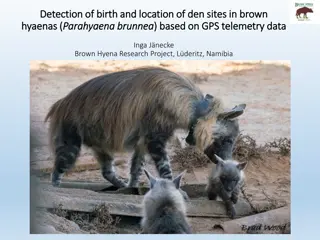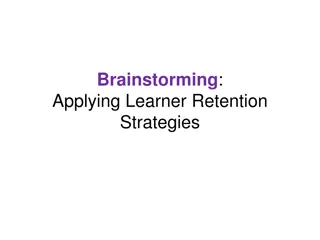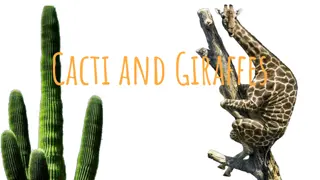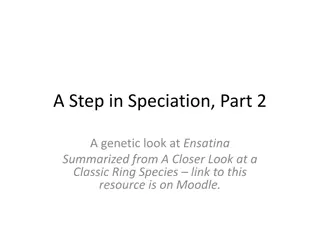Guide to Efficient Rodent Breeding and Colony Management
This comprehensive guide covers essential aspects of rodent breeding, colony management, and tips for successful rodent reproduction. It includes details on weaning, retiring breeders, records management, problem-solving, resources, goals and planning, breeding systems, reproduction processes, genot
4 views • 35 slides
Insights into Male Animal Sexual Behavior and Mating Patterns
Explore various aspects of sexual behavior in male animals, including innate mating behaviors, promiscuity, breeding seasons, and unique reproductive patterns such as pederasty and onanism. Learn about the genetic, environmental, and systematic factors shaping male sexual behavior, arousal mechanism
0 views • 35 slides
Understanding Inbreeding and Its Consequences in Animal Genetics & Breeding
Inbreeding in animal breeding involves mating closely related individuals, resulting in common ancestors within the preceding generations. This practice can have both positive and negative consequences on genetic diversity and health. Various types of inbreeding such as selfing, full-sib mating, and
0 views • 18 slides
Principles of Animal Breeding: Introduction and Historical Perspective
This unit covers the introduction to animal breeding, the application of genetics principles in breeding, historical perspectives including the work of Robert Bakewell, and key events in animal breeding evolution. Topics include breeding systems, importance of animal breeding, and notable figures in
1 views • 12 slides
The Fascinating World of Sericulture: Rearing and Harvesting Silk Insects
Sericulture, the art of rearing and nurturing silk insects, has been practiced since ancient times, yielding the exquisite natural fiber known as silk. This fine material has captivated humans for its beauty and versatility. The process involves skill and scientific knowledge, with various types of
0 views • 16 slides
Effective Strategies for Rural Marketing and Promotion
Evolving effective strategies for rural marketing involves segmentation of the heterogeneous rural market, identification of different segment needs, and formulating marketing mix strategies related to product, price, place, and promotion. Product strategies include small unit packaging and new desi
1 views • 44 slides
Adaptation of Yak and Mithun at High Altitude
Yak and Mithun are domesticated bovids known for their adaptation to high altitudes in the Himalayan region. Yaks, descended from wild yaks, are used for various purposes like transportation, climbing, and trekking. They have specific mating behaviors and unique anatomical modifications for high alt
0 views • 18 slides
Understanding the Social Life of Bees
Honeybees exhibit highly organized social behavior within their colonies, comprising a queen, drones, and worker bees. The queen lays eggs and emits pheromones to regulate worker behavior. Worker bees collect nectar to produce honey, a beneficial substance rich in essential nutrients. Various specie
1 views • 17 slides
Understanding Inbreeding in Animal Genetics & Breeding
Explore the principles of animal breeding theory focusing on inbreeding and its consequences, including examples like selfing, full-sib mating, and genetic effects. Learn about close breeding, line breeding, and genetic consequences of inbreeding in animal populations. Discover how inbreeding affect
0 views • 13 slides
Principles of Animal Breeding: Outbreeding and Its Classification
Outbreeding involves mating animals less closely related than the average population. It includes outcrossing, crossbreeding, grading up, and species hybridization. Outbreeding increases heterozygosity but decreases homozygosity. Heterosis, or hybrid vigor, shows the superiority of outbreds over par
0 views • 32 slides
Principles and Systems of Poultry Breeding: A Comprehensive Guide
Poultry breeding, led by experts like Dr. Suchit Kumar, involves purposeful selection and mating to improve size, weight, egg production, and meat quality. Environmental factors are crucial, and different breeding systems like inbreeding and line breeding play a role in genetic improvement. Continuo
1 views • 21 slides
Understanding Prezygotic Reproductive Isolating Mechanisms
Prezygotic reproductive isolating mechanisms prevent mating or fertilization between different species before it can occur. Examples include habitat isolation, behavioral isolation, and temporal isolation. These mechanisms play a significant role in maintaining species integrity and preventing the f
0 views • 4 slides
Understanding Oxyuris equi: Horse Pinworm Infection
Explore the general characteristics, hosts, life cycle, transmission, and pathogenesis of Oxyuris equi, a pinworm that infects horses and donkeys. Learn about its unique features, including the hour-glass-shaped oesophagus, mating behavior, and effects on its hosts.
0 views • 13 slides
Livestock Skillathon Quiz Questions
Test your knowledge on livestock-related topics with this quiz featuring questions on mating systems, goat dehydration, mineral balance, muscle fat intermingling, body condition scoring, swine teeth, genetic structures, nutrient requirements, and livestock terminology.
1 views • 12 slides
Understanding Population Genetics and Allele Frequency Changes
Population genetics explores how allele frequencies change within populations due to factors like mutations, migration, genetic drift, nonrandom mating, and natural selection. Mutations introduce new variations, migration affects gene flow, genetic drift causes random allele loss, and examples like
1 views • 18 slides
Understanding Selection Strategies in Animal Genetics and Breeding
Genes influence traits through Additive Gene Action (AGA) and Non-Additive Gene Action (NAGA) in animal breeding. Recurrent Selection (RS) and Reciprocal Recurrent Selection (RRS) play crucial roles in improving animals. Selection for General Combining Ability (GCA) and Specific Combining Ability (S
0 views • 16 slides
Fish Breeding Mating Strategies and Designs for Effective Population Management
Designing mating strategies to maximize the effective breeding population in fish hatcheries is crucial for maintaining genetic diversity and overall fitness. Random mating, simple paired mating, factorial mating, and other breeding designs are discussed to help hatchery managers improve breeding co
4 views • 13 slides
Exploring the Fascinating Life Cycle of a Banana Spider
Delve into the intriguing world of banana spiders with details on their appearance, gender differences, mating behaviors, and size variations. Discover why these arachnids are commonly called banana spiders and unravel the unique characteristics that make them stand out in the spider kingdom.
0 views • 5 slides
Innovative Solution for Long Mating Connector Alignment
This solution addresses alignment concerns over a 3m distance between connector boards by modifying the PCB design, using oversized holes, and implementing a new assembly sequence. By replacing connectors, strategically assembling components, and soldering carefully, the process ensures successful m
0 views • 13 slides
Understanding Basic Hole and Shaft Systems in Manufacturing Processes
Basic Hole and Shaft Systems are essential procedures for determining mating part dimensions and tolerance information in manufacturing drawings. By knowing parameters such as Basic Size, Allowance, Hole Tolerance, and Shaft Tolerance, accurate and functional parts can be produced. This system ensur
0 views • 36 slides
Understanding Hardy-Weinberg Principle and Genetic Frequencies
Gene pool and allele frequencies play a crucial role in the Hardy-Weinberg Principle, a mathematical model predicting allele frequencies over generations. The principle outlines conditions like a large population, absence of mutations, random mating, and more. Equations such as p² + 2pq + q² = 1 h
0 views • 44 slides
Study on Birth Detection and Den Site Location in Brown Hyaenas
This research project in Namibia focuses on using GPS telemetry data to detect birth, determine den site locations, and monitor population data for Brown Hyaenas. The study aims to monitor estrus, courtship/mating duration, parturition date, and den occupancy. Images depicting denning behaviors, obj
0 views • 16 slides
Shark Circulatory, Respiratory & Reproductive Systems Overview
A detailed look into the circulation, respiration, and reproductive systems of sharks. The circulatory system of sharks includes a unique heat retention mechanism due to red muscle activity, with blood flowing from the heart to gills and back. The respiratory system involves heat generation in red m
0 views • 10 slides
Reproduction Processes of Eagle, Dolphin, and Giraffe Explained
Eagle, dolphin, and giraffe reproduction processes described including mating, gestation periods, and embryonic development. Eagles mate on branches, dolphins give birth after 12 months, and giraffes mate using urine tasting. Embryo development details for each species are also provided, showcasing
0 views • 14 slides
Comparing Reproduction: Bread Mold vs. Seahorse
Understanding the processes of asexual and sexual reproduction, this content delves into the unique methods of bread mold and seahorses. While bread mold reproduces both asexually and sexually, seahorses only reproduce sexually. Dive into the details of spores, zygotes, mating types, pouch birthing,
0 views • 8 slides
Understanding Bacterial Form and Function: Structures, Shapes, and Arrangements
Explore the diverse structures common to bacterial cells, including membranes, ribosomes, and chromosomes. Learn about the shapes and arrangements of bacteria, such as cocci, bacilli, and spirilla. Discover external appendages that provide motility and aid in attachment and mating.
0 views • 85 slides
Teen Mating Game - Relationship Situation Cards Scenarios
Explore various relationship scenarios depicted through situation cards in the Teen Mating Game. From annoying habits to revelations about sexuality, cheating, financial dynamics, health issues, distance challenges, personal preferences, familial opinions, substance use, and more, these cards offer
0 views • 17 slides
Enhancing Learner Retention: Strategies and Application
Designing effective learning solutions requires implementing various learner retention strategies such as pre-course reading, quizzes, and post-course reflection. Different modes of delivery, including online, synchronous, classroom, and blended approaches, impact the effectiveness of these strategi
1 views • 8 slides
Giant Panda - Overview of Behavior, Feeding, and Breeding Habits
The Giant Panda, scientifically known as Ailuropoda melanoleuca, is a unique animal belonging to the Carnivora order. They exhibit solitary behavior but communicate through various means. Despite being classified as carnivores, they primarily feed on bamboo shoots. Breeding habits include mating bet
0 views • 9 slides
Insights into Fruit Bats: Behavior, Growth, and Senses
Fruit bats, also known as flying foxes, exhibit a wide variation in size, with some as small as two inches and others over 16 inches long. They are equipped with excellent vision and sense of smell, aiding in finding food sources and avoiding danger. Fruit bats have unique feeding habits with sharp
0 views • 9 slides
Fascinating Facts about Cacti and Giraffes: A Natural Comparison
Discover intriguing details about cacti and giraffes - from their reproductive strategies and habitats to their unique features. While cacti can reproduce sexually and asexually, giraffes rely on specific mating seasons. Learn about their lifespans and the challenges they face in the wild. Explore t
0 views • 7 slides
Understanding Aggression: Exploring Its Evolutionary Roots
Delve into the complexities of human aggression, questioning whether it is inherent or a learned behavior. Explore evolutionary theories and biological perspectives on the causes of aggression, examining how factors such as genetics, brain structures, hormones, and environmental pressures may influe
0 views • 11 slides
Understanding Evolutionary Theories and Strategies
Exploring evolutionary theories such as Sexual Selection Theory and Gene Selection Theory sheds light on how characteristics evolve for mating advantage. Insights into intersexual and intrasexual competition offer a deeper understanding of mate selection preferences. Gene selection mechanisms influe
0 views • 20 slides
Understanding Natural Selection and Its Mechanisms
Explore the concepts of natural selection, survival of the fittest, and various types of selection processes in evolutionary biology. From the struggle for existence to sexual selection, learn how organisms adapt to their environment through genetic contributions and mating strategies. Discover exam
0 views • 8 slides
Understanding Effects of Sexual Conflict on Female Longevity in Drosophila
Exploring the impact of male ejaculate protein on the lifespan of mated female Drosophila by analyzing egg production, fertility, mating costs, and the interaction between different treatments. Results suggest that fertile and sterile females, as well as those exposed to high-cost vs. low-cost males
0 views • 7 slides
The Enchanting World of Monk Parakeets – Learn About These Vibrant Birds
Monk parakeets, also known as Quaker parrots, are small- to medium-sized members of the parrot family originating from Australia, New Zealand, Central America, and South America. They are green with hints of gray and are officially classified as Myiopsitta Monachus. Throughout history, they have bee
0 views • 8 slides
Teen Mating Game Discussion Cards by School Health Team
Explore the Teen Mating Game Discussion Cards created by the School Health Team in July 2022. The cards provide insights on behavior and communication when someone is "into" or not "into" someone else. Discover the cues and actions that indicate interest or lack thereof in a potential partner or cru
0 views • 5 slides
Understanding Selective Breeding: Benefits and Process
Selective breeding is a method where humans control the breeding of organisms to emphasize or eliminate specific traits. By choosing parents with desirable characteristics, breeders aim to create offspring with those traits. While advantageous for creating economically important varieties, it can al
0 views • 12 slides
Genetic Insights into Ensatina: A Study of Ring Species Speciation
Genetic analysis of Ensatina populations in California by Tom Devitt and team revealed complex groupings challenging previous taxonomic classifications. Hybridization patterns and hypotheses are explored, shedding light on post-mating isolation mechanisms. The study utilizes mitochondrial DNA sequen
0 views • 10 slides
Understanding Hardy-Weinberg Equilibrium in Population Genetics
The Hardy-Weinberg Equilibrium (HWE) equation provides insights into allele frequencies in a population under ideal conditions, with key requirements being no mutations, no natural selection, no gene flow, infinite or large population size, and random mating. Deviations from HWE indicate evolutionar
0 views • 5 slides


